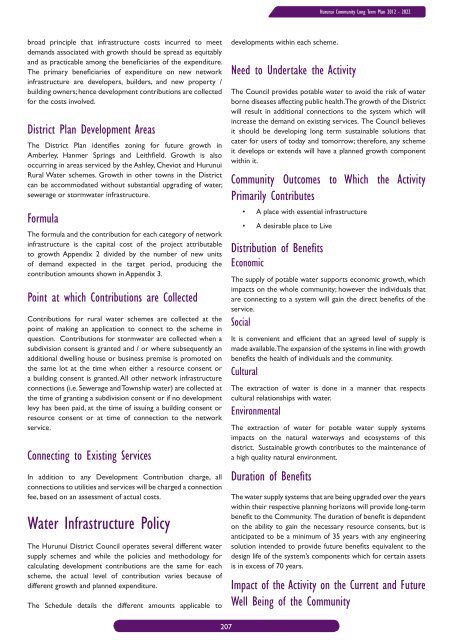Long Term Community Plan 2012-2022 - Hurunui District Council
Long Term Community Plan 2012-2022 - Hurunui District Council
Long Term Community Plan 2012-2022 - Hurunui District Council
Create successful ePaper yourself
Turn your PDF publications into a flip-book with our unique Google optimized e-Paper software.
<strong>Hurunui</strong> <strong>Community</strong> <strong>Long</strong> <strong>Term</strong> <strong>Plan</strong> <strong>2012</strong> - <strong>2022</strong><br />
broad principle that infrastructure costs incurred to meet<br />
demands associated with growth should be spread as equitably<br />
and as practicable among the beneficiaries of the expenditure.<br />
The primary beneficiaries of expenditure on new network<br />
infrastructure are developers, builders, and new property /<br />
building owners; hence development contributions are collected<br />
for the costs involved.<br />
<strong>District</strong> <strong>Plan</strong> Development Areas<br />
The <strong>District</strong> <strong>Plan</strong> identifies zoning for future growth in<br />
Amberley, Hanmer Springs and Leithfield. Growth is also<br />
occurring in areas serviced by the Ashley, Cheviot and <strong>Hurunui</strong><br />
Rural Water schemes. Growth in other towns in the <strong>District</strong><br />
can be accommodated without substantial upgrading of water,<br />
sewerage or stormwater infrastructure.<br />
Formula<br />
The formula and the contribution for each category of network<br />
infrastructure is the capital cost of the project attributable<br />
to growth Appendix 2 divided by the number of new units<br />
of demand expected in the target period, producing the<br />
contribution amounts shown in Appendix 3.<br />
Point at which Contributions are Collected<br />
Contributions for rural water schemes are collected at the<br />
point of making an application to connect to the scheme in<br />
question. Contributions for stormwater are collected when a<br />
subdivision consent is granted and / or where subsequently an<br />
additional dwelling house or business premise is promoted on<br />
the same lot at the time when either a resource consent or<br />
a building consent is granted. All other network infrastructure<br />
connections (i.e. Sewerage and Township water) are collected at<br />
the time of granting a subdivision consent or if no development<br />
levy has been paid, at the time of issuing a building consent or<br />
resource consent or at time of connection to the network<br />
service.<br />
Connecting to Existing Services<br />
In addition to any Development Contribution charge, all<br />
connections to utilities and services will be charged a connection<br />
fee, based on an assessment of actual costs.<br />
Water Infrastructure Policy<br />
The <strong>Hurunui</strong> <strong>District</strong> <strong>Council</strong> operates several different water<br />
supply schemes and while the policies and methodology for<br />
calculating development contributions are the same for each<br />
scheme, the actual level of contribution varies because of<br />
different growth and planned expenditure.<br />
The Schedule details the different amounts applicable to<br />
developments within each scheme.<br />
Need to Undertake the Activity<br />
The <strong>Council</strong> provides potable water to avoid the risk of water<br />
borne diseases affecting public health. The growth of the <strong>District</strong><br />
will result in additional connections to the system which will<br />
increase the demand on existing services. The <strong>Council</strong> believes<br />
it should be developing long term sustainable solutions that<br />
cater for users of today and tomorrow; therefore, any scheme<br />
it develops or extends will have a planned growth component<br />
within it.<br />
<strong>Community</strong> Outcomes to Which the Activity<br />
Primarily Contributes<br />
• A place with essential infrastructure<br />
• A desirable place to Live<br />
Distribution of Benefits<br />
Economic<br />
The supply of potable water supports economic growth, which<br />
impacts on the whole community; however the individuals that<br />
are connecting to a system will gain the direct benefits of the<br />
service.<br />
Social<br />
It is convenient and efficient that an agreed level of supply is<br />
made available. The expansion of the systems in line with growth<br />
benefits the health of individuals and the community.<br />
Cultural<br />
The extraction of water is done in a manner that respects<br />
cultural relationships with water.<br />
Environmental<br />
The extraction of water for potable water supply systems<br />
impacts on the natural waterways and ecosystems of this<br />
district. Sustainable growth contributes to the maintenance of<br />
a high quality natural environment.<br />
Duration of Benefits<br />
The water supply systems that are being upgraded over the years<br />
within their respective planning horizons will provide long-term<br />
benefit to the <strong>Community</strong>. The duration of benefit is dependent<br />
on the ability to gain the necessary resource consents, but is<br />
anticipated to be a minimum of 35 years with any engineering<br />
solution intended to provide future benefits equivalent to the<br />
design life of the system’s components which for certain assets<br />
is in excess of 70 years.<br />
Impact of the Activity on the Current and Future<br />
Well Being of the <strong>Community</strong><br />
207

















